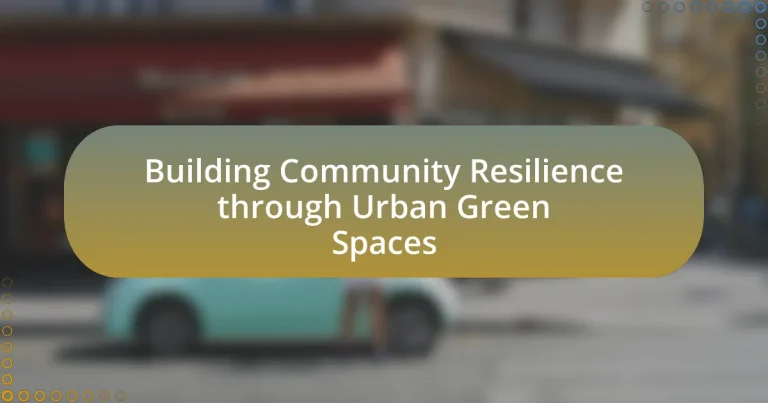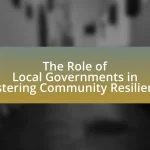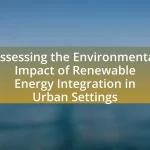Building community resilience through urban green spaces involves integrating parks, gardens, and green roofs into urban planning to enhance a community’s ability to cope with environmental, social, and economic challenges. Urban green spaces provide numerous benefits, including improved mental health, increased biodiversity, and enhanced social cohesion, which are essential for fostering resilience. Research indicates that accessible green spaces contribute to lower stress levels, higher community engagement, and better disaster preparedness. Effective urban green spaces, such as parks and community gardens, not only support ecological balance but also promote social interactions and community ties, ultimately improving the overall quality of life in urban areas.
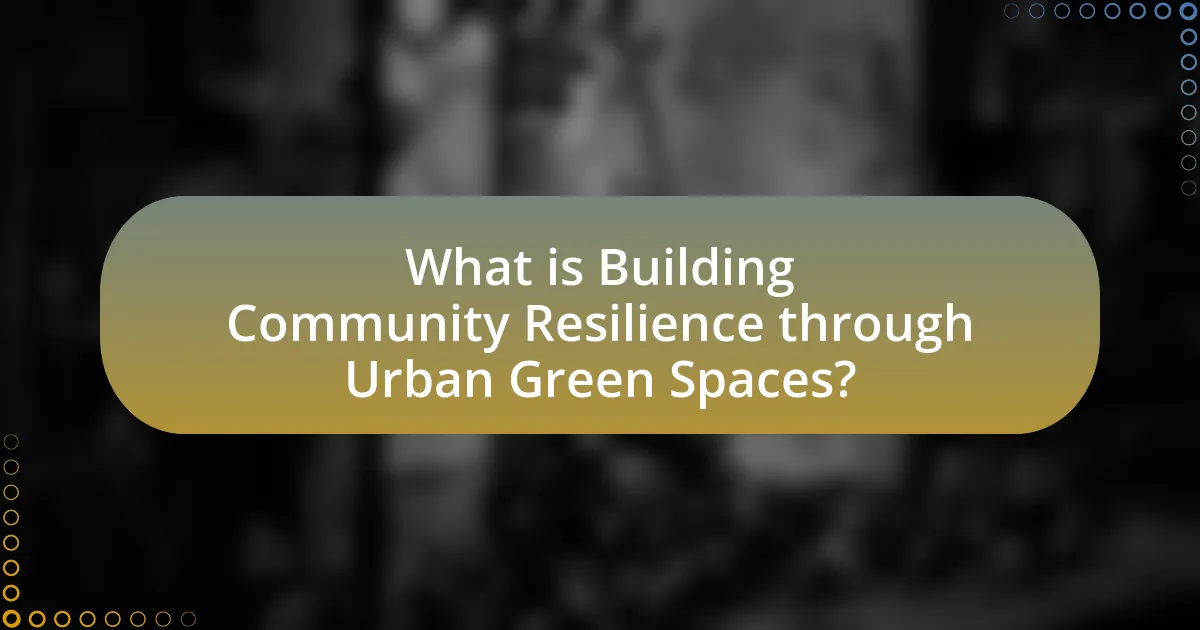
What is Building Community Resilience through Urban Green Spaces?
Building community resilience through urban green spaces refers to the process of enhancing a community’s ability to withstand and recover from environmental, social, and economic challenges by integrating green areas into urban planning. Urban green spaces, such as parks, gardens, and green roofs, provide essential benefits including improved mental health, increased biodiversity, and enhanced social cohesion. Research indicates that communities with accessible green spaces experience lower levels of stress and higher levels of community engagement, which are critical for resilience. For instance, a study published in the journal “Environmental Science & Policy” found that urban green spaces significantly contribute to community well-being and disaster preparedness, demonstrating their role in fostering resilience.
How do urban green spaces contribute to community resilience?
Urban green spaces enhance community resilience by providing essential ecosystem services, promoting social cohesion, and improving mental and physical health. These areas, such as parks and community gardens, serve as critical buffers during environmental stressors like heatwaves and flooding, reducing urban heat and managing stormwater. Research indicates that neighborhoods with accessible green spaces experience lower rates of crime and increased community interaction, fostering stronger social networks. For instance, a study published in the journal “Environmental Science & Policy” found that urban green spaces significantly contribute to community well-being and resilience by enhancing social ties and providing a sense of belonging.
What types of urban green spaces are most effective for resilience?
Urban green spaces that are most effective for resilience include parks, green roofs, community gardens, and urban forests. These types of green spaces enhance biodiversity, improve air quality, and provide recreational opportunities, which contribute to community well-being and environmental sustainability. For instance, urban forests can reduce urban heat islands by lowering temperatures, while community gardens foster social cohesion and food security. Research indicates that cities with ample green spaces experience lower rates of heat-related illnesses and improved mental health outcomes, demonstrating their critical role in enhancing urban resilience.
How do urban green spaces enhance social cohesion within communities?
Urban green spaces enhance social cohesion within communities by providing shared environments that encourage interaction and collaboration among residents. These spaces, such as parks and gardens, serve as venues for social activities, fostering relationships and a sense of belonging. Research indicates that communities with accessible green spaces report higher levels of social engagement and trust among neighbors, as evidenced by a study published in the Journal of Environmental Psychology, which found that individuals living near parks are more likely to participate in community events and volunteer activities. Additionally, urban green spaces can reduce social isolation by offering a welcoming atmosphere for diverse groups to gather, thereby strengthening community ties and promoting inclusivity.
Why is community resilience important in urban areas?
Community resilience is important in urban areas because it enhances the ability of communities to withstand and recover from adverse events such as natural disasters, economic downturns, and social disruptions. Resilient communities can mobilize resources, support networks, and adaptive strategies that mitigate the impacts of these challenges. For instance, research indicates that urban areas with strong community ties and engagement experience faster recovery times after disasters, as seen in the aftermath of Hurricane Sandy, where neighborhoods with established social networks were able to coordinate aid and support more effectively. This demonstrates that community resilience not only improves individual well-being but also strengthens the overall stability and sustainability of urban environments.
What challenges do urban communities face that resilience can address?
Urban communities face challenges such as climate change impacts, social inequality, and infrastructure strain that resilience can address. Climate change leads to increased flooding, heatwaves, and air pollution, which urban resilience strategies can mitigate through green infrastructure like parks and green roofs. Social inequality manifests in limited access to resources and services, which resilience initiatives can tackle by fostering community engagement and equitable resource distribution. Additionally, aging infrastructure often struggles to meet the demands of growing populations; resilience planning can enhance infrastructure adaptability and sustainability, as evidenced by cities implementing green spaces to improve stormwater management and reduce urban heat islands.
How does resilience impact the overall quality of life in cities?
Resilience significantly enhances the overall quality of life in cities by enabling communities to effectively respond to and recover from various challenges, such as natural disasters, economic downturns, and social disruptions. For instance, cities with resilient infrastructure and community networks can maintain essential services during crises, which directly contributes to public safety and well-being. Research indicates that urban areas with green spaces, which are integral to resilience, promote mental health, reduce heat stress, and improve air quality, thereby fostering a healthier living environment. A study by the University of Exeter found that access to green spaces can lead to a 15% increase in overall well-being, demonstrating the tangible benefits of resilience in urban settings.
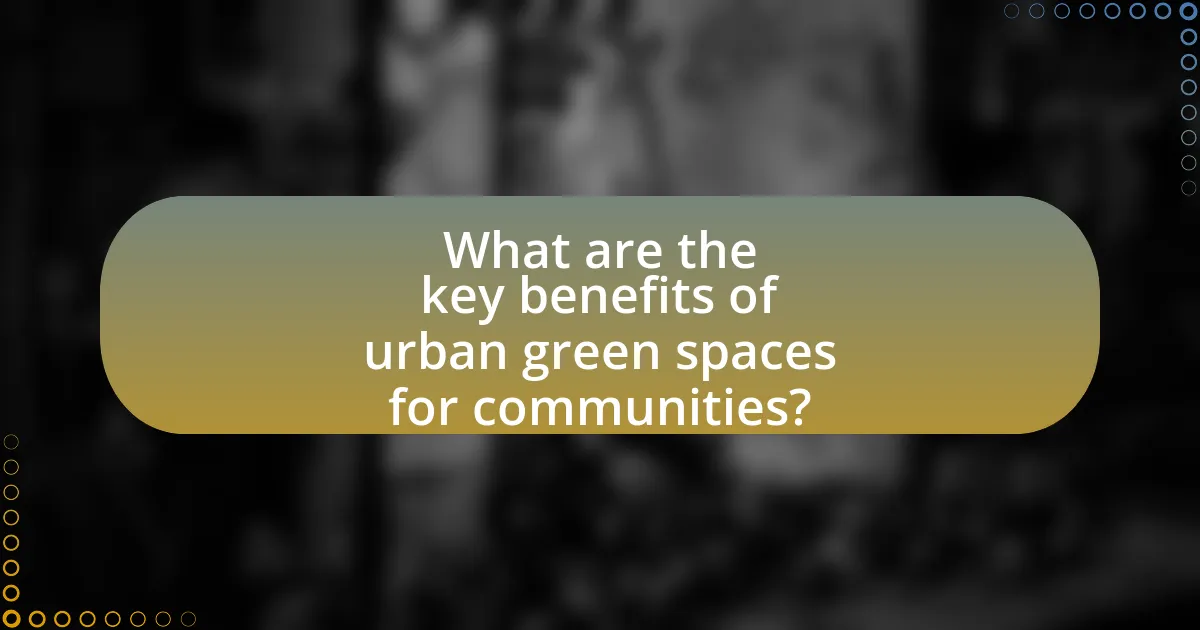
What are the key benefits of urban green spaces for communities?
Urban green spaces provide essential benefits for communities, including improved mental health, enhanced social cohesion, and increased biodiversity. Research indicates that access to green spaces can reduce stress and anxiety levels, as demonstrated by a study published in the Journal of Environmental Psychology, which found that individuals who spend time in nature report higher levels of well-being. Additionally, urban green spaces foster social interactions, as parks and gardens serve as gathering places that strengthen community ties. A report from the National Recreation and Park Association highlights that neighborhoods with accessible parks experience lower crime rates and higher community engagement. Furthermore, these spaces support biodiversity by providing habitats for various species, contributing to ecological balance. Overall, urban green spaces are vital for promoting healthier, more connected, and sustainable communities.
How do urban green spaces improve mental and physical health?
Urban green spaces significantly improve mental and physical health by providing environments that promote relaxation, physical activity, and social interaction. Research indicates that access to parks and green areas reduces stress, anxiety, and depression, while also encouraging exercise, which is essential for physical well-being. A study published in the journal “Environmental Science & Technology” found that individuals living near green spaces reported better mental health outcomes and lower levels of psychological distress. Additionally, green spaces facilitate community engagement, fostering social ties that contribute to overall resilience and well-being.
What evidence supports the health benefits of green spaces?
Research indicates that green spaces significantly enhance public health by reducing stress, improving mental well-being, and promoting physical activity. A study published in the journal “Environmental Science & Technology” found that individuals living near green spaces reported lower levels of anxiety and depression, with a 30% reduction in stress-related illnesses. Additionally, the World Health Organization highlights that access to green areas encourages physical activities such as walking and cycling, contributing to lower obesity rates and improved cardiovascular health. Furthermore, a meta-analysis in “Landscape and Urban Planning” demonstrated that urban greenery is associated with increased social cohesion, which further supports mental health and community resilience.
How can access to green spaces reduce stress and anxiety?
Access to green spaces can significantly reduce stress and anxiety by providing a natural environment that promotes relaxation and mental well-being. Studies have shown that exposure to nature lowers cortisol levels, a hormone associated with stress, and enhances mood through increased serotonin production. For instance, research published in the journal “Environmental Science & Technology” by Mitchell and Popham (2008) found that individuals living in greener urban areas reported better mental health outcomes compared to those in less green environments. Additionally, engaging in activities like walking or gardening in these spaces can foster social interactions, further alleviating feelings of isolation and anxiety.
What role do urban green spaces play in environmental sustainability?
Urban green spaces play a crucial role in environmental sustainability by enhancing biodiversity, improving air quality, and mitigating urban heat effects. These areas provide habitats for various species, which contributes to ecological balance and resilience. Research indicates that urban greenery can reduce air pollution levels by up to 30%, as plants absorb pollutants and produce oxygen. Additionally, green spaces help lower urban temperatures through shade and evapotranspiration, which can reduce energy consumption for cooling. Studies show that cities with more green areas experience lower heat-related health issues, demonstrating their importance in promoting public health and environmental stability.
How do green spaces contribute to biodiversity in urban settings?
Green spaces contribute to biodiversity in urban settings by providing habitats for various species, including plants, insects, birds, and mammals. These areas serve as critical refuges that support ecological networks, allowing species to thrive amidst urban development. Research indicates that urban green spaces can increase species richness; for example, a study published in “Urban Ecology” found that parks and gardens can host up to 30% more species compared to surrounding urban areas. Additionally, green spaces facilitate ecological processes such as pollination and seed dispersal, which are essential for maintaining healthy ecosystems.
What are the ecological benefits of integrating green spaces into urban planning?
Integrating green spaces into urban planning provides significant ecological benefits, including improved biodiversity, enhanced air quality, and effective stormwater management. Green spaces serve as habitats for various species, promoting biodiversity in urban environments; for instance, urban parks can support over 100 species of birds and numerous insects. Additionally, vegetation in these areas absorbs pollutants and carbon dioxide, leading to better air quality; studies show that urban trees can remove up to 1.1 million tons of air pollutants annually in cities like New York. Furthermore, green spaces facilitate stormwater management by absorbing rainwater, reducing runoff, and minimizing flooding risks; research indicates that urban green infrastructure can reduce surface runoff by up to 65%. These ecological benefits collectively contribute to healthier urban ecosystems and improved quality of life for residents.
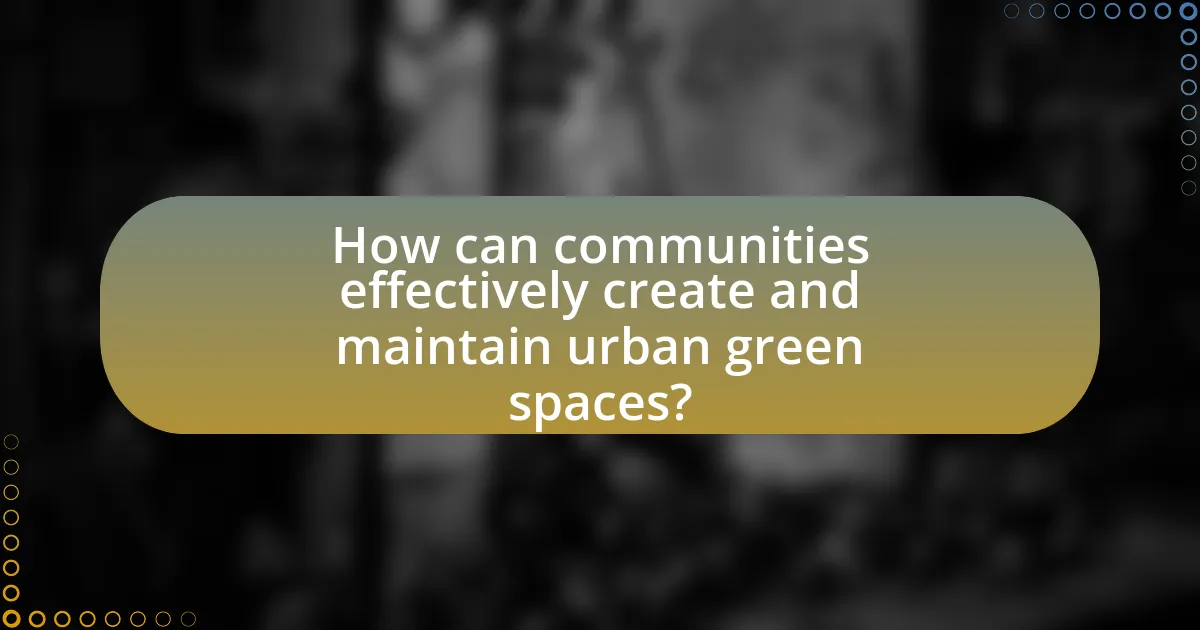
How can communities effectively create and maintain urban green spaces?
Communities can effectively create and maintain urban green spaces by engaging local residents in the planning and decision-making processes, ensuring that these spaces meet the needs of the community. Collaborative efforts, such as community workshops and surveys, allow residents to express their preferences and ideas, leading to more relevant and utilized green spaces.
Additionally, establishing partnerships with local organizations, schools, and businesses can provide resources and support for the development and upkeep of these areas. For instance, the National Recreation and Park Association highlights that community involvement in park design increases usage and satisfaction, which is crucial for long-term maintenance.
Regular maintenance can be achieved through volunteer programs and community stewardship initiatives, where residents take responsibility for the care of their local green spaces. Research from the University of Illinois indicates that neighborhoods with active stewardship programs report higher levels of community and environmental awareness, further enhancing the sustainability of urban green spaces.
What strategies can communities use to develop urban green spaces?
Communities can develop urban green spaces by implementing strategies such as community engagement, collaborative planning, and securing funding through grants. Community engagement involves involving local residents in the design and maintenance of green spaces, which fosters a sense of ownership and responsibility. Collaborative planning can be achieved by partnering with local governments, non-profits, and businesses to create comprehensive plans that address community needs and environmental sustainability. Securing funding through grants from organizations like the Land and Water Conservation Fund can provide necessary financial resources for these projects. These strategies have been shown to enhance community resilience by improving mental health, increasing biodiversity, and mitigating urban heat effects.
How can community involvement enhance the success of green space projects?
Community involvement enhances the success of green space projects by fostering local ownership and ensuring that the spaces meet the specific needs of the community. Engaging residents in the planning and design process leads to increased satisfaction and usage of the green spaces, as studies show that projects with community input are more likely to be utilized effectively. For instance, a study published in the Journal of Urban Planning and Development found that community-led initiatives resulted in a 30% higher usage rate of parks compared to those developed without local input. This active participation not only promotes stewardship but also strengthens social ties, contributing to the overall resilience of the community.
What funding sources are available for urban green space initiatives?
Funding sources available for urban green space initiatives include government grants, private foundations, corporate sponsorships, and crowdfunding platforms. Government grants, such as those from the Environmental Protection Agency or local municipalities, often support projects aimed at enhancing urban greenery. Private foundations, like the Trust for Public Land, provide funding specifically for green space development. Corporate sponsorships can also be a significant source, as companies seek to enhance their community engagement and corporate social responsibility. Additionally, crowdfunding platforms allow community members to contribute directly to local green space projects, fostering community involvement and investment.
What best practices should be followed for maintaining urban green spaces?
Best practices for maintaining urban green spaces include regular maintenance, community involvement, and sustainable practices. Regular maintenance involves tasks such as mowing, pruning, and litter removal to ensure the space remains safe and aesthetically pleasing. Community involvement encourages local residents to participate in the upkeep and stewardship of these areas, fostering a sense of ownership and responsibility. Sustainable practices, such as using native plants and implementing efficient irrigation systems, enhance biodiversity and reduce resource consumption. Research indicates that well-maintained green spaces contribute to improved mental health and community cohesion, reinforcing their importance in urban environments.
How can communities ensure the sustainability of their green spaces?
Communities can ensure the sustainability of their green spaces by implementing effective management practices, engaging in community involvement, and promoting biodiversity. Effective management practices include regular maintenance, such as pruning, weeding, and irrigation, which are essential for the health of green spaces. Community involvement fosters a sense of ownership and responsibility, leading to volunteer programs for upkeep and educational initiatives about the importance of green spaces. Promoting biodiversity through native plant landscaping and habitat creation supports local ecosystems, enhancing resilience against climate change. Research indicates that communities with active participation in green space management report higher satisfaction and better environmental outcomes, demonstrating the effectiveness of these strategies.
What role do local governments play in the maintenance of urban green spaces?
Local governments are essential in the maintenance of urban green spaces by providing funding, implementing policies, and managing resources. They allocate budgets specifically for the upkeep of parks and green areas, ensuring that these spaces are regularly maintained and accessible to the community. For instance, a study by the National Recreation and Park Association indicates that local governments invest approximately $140 billion annually in public parks and recreation, highlighting their commitment to maintaining urban green spaces. Additionally, local governments enforce regulations that protect these areas from development and degradation, thereby promoting biodiversity and enhancing community well-being.
What are practical tips for engaging the community in urban green space projects?
To effectively engage the community in urban green space projects, initiate inclusive planning sessions that invite diverse community members to share their ideas and preferences. Research indicates that participatory design processes, such as those highlighted in the “Community Participation in Urban Green Spaces” study by the University of California, enhance community ownership and satisfaction with green spaces. Additionally, organizing volunteer days for planting and maintenance fosters a sense of stewardship and connection among residents, as evidenced by the success of similar initiatives in cities like Portland, Oregon, where community involvement has led to increased usage and care for local parks.
